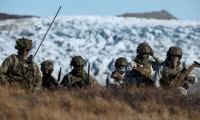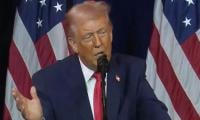The world’s biggest land grab - Part II
Who could have thought that India would see the day when religious violence in that country would overshadow visits by top leaders from America and Japan?
This is exactly what happened in December 2019 when Japanese Prime Minister Shinzo Abe canceled a visit due to violence on Indian streets over a discriminatory citizenship law. And in February 2020, when the security team of US President Donald Trump, working with Indian counterparts, skipped the Indian capital altogether for the first time by a visiting American president, because New Delhi was not safe due to religion-motivated violence.
This is how an article in Time magazine, on Feb 29, described the American president’s stay in India two months after Japan’s PM Abe had canceled his trip: “It takes a lot to overshadow a foreign visit by a sitting US president. India managed the feat this week, as Delhi was plunged into violent chaos as protests over India’s controversial new citizenship law reached disturbing new levels.”
In fact, who thought a day would come when Ian Bremmer, president of Eurasia Group, the world’s foremost political risk research firm, would choose this title for his article on India in Time magazine: ‘What happens next with the violence tearing apart India’.
And the caveat here is tearing apart because this is the crux of India’s emerging new story, which has overshadowed the other narrative about India as a model for developing states.
India is tearing itself apart in ways that the nation has not seen in centuries, or possibly ever. And the world is finally paying attention. Imagine a country the size of India, over a billion people, where religion is being weaponized, generating massive unrest that could end in violence on an unprecedented scale.
And Kashmir is at the core of India’s internal discord. Kashmir is changing India more than India could ever change Kashmir. A nation that was supposed to show the world how to solve conflict sans violence, like Gandhi did, is growing angrier, bitter and more violent. Instead of ending violence inside Kashmir, India now sees violence spreading across mainland India.
The world has changed its view on Kashmir. The conflict is no longer about terrorism. The terms ‘cross-border terror’ and ‘infiltration’, promoted to the hilt by the Indian diplomacy in the 1990s and after 9/11, are no longer associated with Kashmir in international media today.
The UN’s top human rights office has placed Kashmir back on the international agenda in its annual policy statements at the Human Rights Council, starting in September 2016. That is when the extrajudicial murder of Burhan Wani by Indian soldiers engulfed the region in a new crisis that India could not handle.
The UN Security Council’s two formal meetings on Kashmir, the first in more than a half-century, went ahead despite intense Indian lobbying in the background to block them. India’s role in Kashmir is now the subject of probing international investigative journalism at levels that even Pakistan’s media cannot match. And the Gulf States are deporting extremist-minded Indian residents who support the Indian government’s agenda in Kashmir and exhibit Islamophobia in their social media posts.
Something has changed in Washington as well. India’s market clout failed to stop President Trump from repeating the K-word, which is anathema to Indian policy because it rightly implies that Kashmir is an international dispute open to mediation and not an internal matter for the Indian government. The Indian foreign ministry is grappling with a new phenomenon where senior Indian officials face questions about Kashmir at forums that used to be oblivious to the conflict.
India’s global position on Kashmir is so tenuous that the Office of the High Commissioner for Human Rights released the UN’s first-ever report on Kashmir, in June 2018, detailing patterns of abuses that have normally been associated with dictatorships and not the world’s largest democracy. For example, the UN report refers to alleged sites of mass graves, and to a case of overnight gang-rape by Indian soldiers of women of all ages in two Kashmiri villages in 1991. The report describes Kashmir as “one of the most militarized zones in the world”, quoting a figure between 500,000 and 700,000 Indian soldiers.
The initial celebrations in India after August 5, 2019 have now given way to brooding over the barrage of international criticism and bad press. Unwittingly, Prime Minister Modi has infused new life into the issue of the Kashmir conflict and turned the global media spotlight on India. Unfortunately for India, this coverage has now expanded beyond Kashmir to include other problems besetting India, like Indian religious extremism and the Hindutva ideology of Modi and his BJP party.
In Western media, there are whispers now comparing Modi to Milosevic, who was indicted for war crimes.
In his article for BBC on August 13, 2019 – titled, ‘Has India pushed Kashmir to a point of no return?’ – Sumantra Bose, a professor of international and comparative politics at the London School of Economics (LSE), compares Aug 5 in Kashmir to the cancellation of Kosovo’s autonomy in 1989, which later led to civil war and genocide.
The world has turned a page on Kashmir. The resulting energy could potentially help India (and Pakistan) resolve the conflict.
To be continued
The writer is a journalist focused on national security and human rights.
Twitter: @_AhmedQuraishi
-
 Defying Age At Milano Cortina Games: Canadian Skater Stellato-Dudeke Aims For Gold At 42
Defying Age At Milano Cortina Games: Canadian Skater Stellato-Dudeke Aims For Gold At 42 -
 Study Finds Screen Time Does Not Harm Teenagers’ Mental Health
Study Finds Screen Time Does Not Harm Teenagers’ Mental Health -
 'Dunesday': What Robert Downey Jr. And Timothee Chalamet Really Think
'Dunesday': What Robert Downey Jr. And Timothee Chalamet Really Think -
 UK Regulator Reaffirms Ongoing Investigation Into X Deepfake Probe
UK Regulator Reaffirms Ongoing Investigation Into X Deepfake Probe -
 'Marty Supreme' Featured Secret Robert Pattinson Cameo?
'Marty Supreme' Featured Secret Robert Pattinson Cameo? -
 ‘Operation Arctic Endurance’: Which NATO Nations Are Sending Troops To Greenland?
‘Operation Arctic Endurance’: Which NATO Nations Are Sending Troops To Greenland? -
 Kate Middleton ‘disgusted’ As Andrew Points Finger At Her Over Royal Downfall
Kate Middleton ‘disgusted’ As Andrew Points Finger At Her Over Royal Downfall -
 YouTube Adds New Parental Controls For Teens, Limits Shorts Scrolling
YouTube Adds New Parental Controls For Teens, Limits Shorts Scrolling -
 Sarah Ferguson Takes Big Decision As Royal Lodge Eviction Looms
Sarah Ferguson Takes Big Decision As Royal Lodge Eviction Looms -
 Bruno Mars Leaves Taylor Swift Behind With Shocking Move
Bruno Mars Leaves Taylor Swift Behind With Shocking Move -
 Trump Administration Imposes 25% Tariff On Imports Of Some AI Chips
Trump Administration Imposes 25% Tariff On Imports Of Some AI Chips -
 Chinese Smartphone Makers Adjust Prices As Costs Go Up
Chinese Smartphone Makers Adjust Prices As Costs Go Up -
 Wikipedia Owner Signs AI Content Training Deals With Microsoft, Meta
Wikipedia Owner Signs AI Content Training Deals With Microsoft, Meta -
 Meghan Markle’s Real Feelings Revealed Amid UK Return Rumours
Meghan Markle’s Real Feelings Revealed Amid UK Return Rumours -
 Reese Witherspoon Issues Urgent Warning After Scammers Using Her Identity
Reese Witherspoon Issues Urgent Warning After Scammers Using Her Identity -
 XAI Restricts Grok Image Editing After Backlash From California And Europe
XAI Restricts Grok Image Editing After Backlash From California And Europe



